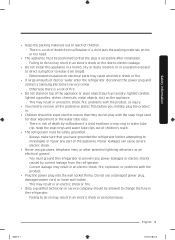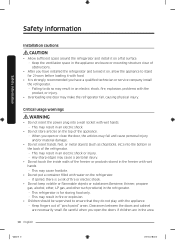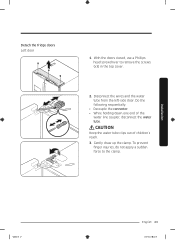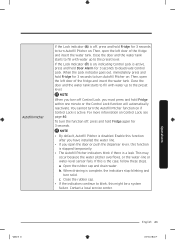Samsung RF23R6201SR/AA Support Question
Find answers below for this question about Samsung RF23R6201SR/AA.Need a Samsung RF23R6201SR/AA manual? We have 1 online manual for this item!
Question posted by Debhollyandian on June 23rd, 2024
Water Is Building Up And Freezing At The Bottom Of The Fridge Portion Of Our Ref
Current Answers
Answer #1: Posted by 618618 on June 23rd, 2024 8:48 PM
3 causes of freezing inside the refrigerator
1_ Defective thermostat
Thermostats are designed to stimulate the cooling process inside the refrigerator if necessary. In a normally functioning refrigerator, the thermostat should automatically shut off as soon as the set temperature is reached. This process is necessary to maintain an optimal and constant temperature. When the thermostat is malfunctioning, it may not turn off, causing it to work continuously.
2_ Damage to the rubber around the refrigerator door
3- Fridge sensor failure
The temperature sensor is a part that sends the current temperature of the refrigerator to parts such as the control board of the compressor circuits and the fan of the device. In case of temperature changes in the refrigerator, the fan and compressor are turned on or off. The cause of freezing inside your frost-free refrigerator may be the failure of the sensor; Because if this part of the refrigerator is damaged, it loses the ability to control the temperature. As a result, either the internal temperature of the refrigerator becomes so hot that the food spoils, or it becomes so cold that the food inside the refrigerator freezes.
How to prevent frosting of the refrigerator?
The most important trick to prevent frosting of the refrigerator is not to open and close the door unnecessarily. For this purpose, it is better to try to remove our necessary items from the refrigerator together.
Ways to prevent frost in the refrigerator
Arrange the food items in the refrigerator in order to spend less time searching for them.
Do not put heavy things on the shelves of the refrigerator door. By observing this, we prevent the refrigerator door from falling.
Wipe the area around the refrigerator door with a damp cloth so that dirt and food does not remain around the door. This makes the rubber around the refrigerator have good adhesion.
To prevent mold in the refrigerator, it is better not to place large containers of food in front of the cooling mechanism of the refrigerator.
Clean the freezer vents every 6 months so that the air flow is not blocked.
What can we do to get rid of the fridge mold?
To clean the mold, first turn off the refrigerator. Then gently remove the thrush from the refrigerator with a wooden or plastic spatula. Be careful not to hit the body of the refrigerator in any way.
Wait for the frostbite to slowly melt. To get rid of thrush faster, you can wet a cloth or towel with boiling water and place it on the thrush.
After all the frost has melted, dry the inside of the refrigerator with a towel. Because the cause of freezing inside the refrigerator without frost is the presence of moisture inside the refrigerator.
After this step, close the refrigerator door and turn it on.
Good luck.
Answer #2: Posted by prakash0322 on June 23rd, 2024 9:52 PM
- Cause: The most common cause of water buildup is a clogged defrost drain. This drain carries water from the automatic defrost system to a pan where it evaporates.
- Solution: Locate the defrost drain hole, typically at the back or bottom of the fridge. Use a turkey baster or a pipe cleaner to clear the blockage. Warm water or a mixture of baking soda and water can help dissolve any ice or debris.
- Cause: The drain line can also get blocked with ice or food particles, preventing proper drainage.
- Solution: Remove the cover of the drain line, and flush it with hot water or a mixture of hot water and baking soda. A flexible brush can help dislodge blockages.
- Cause: If the door seal (gasket) is worn out or damaged, warm air may enter the fridge, causing condensation that can freeze at the bottom.
- Solution: Inspect the door seal for cracks or gaps. Replace it if necessary. Ensure the door closes properly to maintain a consistent temperature.
- Cause: If the refrigerator isn't level, water may not drain properly and could pool at the bottom.
- Solution: Use a spirit level to check the refrigerator's balance. Adjust the leveling feet as needed to ensure the fridge is level from front to back and side to side.
- Cause: If the defrost thermostat or heater isn't working correctly, ice can build up on the evaporator coils and eventually melt and drip to the bottom.
- Solution: Check if the coils are iced over. If they are, you may need to replace the defrost thermostat or heater. This might require professional assistance.
- Cause: Overloading can restrict air circulation, leading to uneven cooling and freezing of water at the bottom.
- Solution: Ensure the fridge is not overfilled and that air can circulate freely around the items. Leave some space between items and the fridge walls.
- Cause: If your fridge has an ice maker, a leak or malfunction could cause water to pool and freeze at the bottom.
- Solution: Inspect the ice maker for leaks or blockages. Check the water supply line and connections for any issues.
- Cause: A clogged or improperly installed water filter can cause leaks or overflow.
- Solution: Check and replace the water filter if necessary. Ensure it is correctly installed.
- Unplug the Refrigerator: For safety, always unplug the appliance before performing any maintenance.
- Remove the Contents: Take out all food items and store them in a cooler.
- Defrost the Refrigerator: Allow the fridge to defrost if there's a significant buildup of ice. You can speed up this process by placing bowls of hot water inside the fridge.
- Clear the Defrost Drain: Locate the drain and clear any blockages. You may need to remove a panel to access it.
- Inspect and Clean: Clean the interior and the drain pan to remove any debris or mold that could cause clogs.
- Check and Replace Seals: Inspect the door seals and replace if damaged. Ensure they are clean and form a proper seal.
- Adjust the Temperature Settings: Set the fridge to the manufacturer's recommended temperature settings to avoid excessive frost buildup.
- Level the Refrigerator: Adjust the feet to ensure the refrigerator is level.
- Test the Ice Maker and Water Filter: Inspect these components for leaks or blockages.
- Reassemble and Restart: Once everything is checked and cleaned, reassemble the fridge, plug it back in, and return the food items.
If the problem persists after trying these solutions, it may be time to contact a professional for further diagnosis and repair. A licensed technician can handle complex issues such as faulty components or significant leaks.
Answer #3: Posted by SonuKumar on June 26th, 2024 9:50 AM
Step 1: Clear the Defrost Drain
The defrost drain allows melted frost to exit the refrigerator. If it's blocked, water can accumulate and freeze.
Empty the Refrigerator:
Remove the vegetable tray and any other items in the way.
Locate the Defrost Drain:
The drain is usually located at the back of the refrigerator, near the bottom.
Clear the Blockage:
Use a turkey baster or a similar tool to flush the drain with warm water.
If there's ice, use a hairdryer on a low setting to melt it, being careful not to overheat any plastic parts.
You can also use a pipe cleaner or a thin, flexible brush to clear any debris.
Step 2: Check the Drain Tube
The drain tube might also be blocked or frozen.
Access the Drain Tube:
The drain tube runs from the inside of the fridge to the drain pan underneath.
You might need to access it from the back of the refrigerator by removing a panel.
Clear the Drain Tube:
Use warm water and a thin, flexible brush or a pipe cleaner to clear any blockages.
Step 3: Check the Evaporator Coil and Fan
A malfunctioning evaporator coil or fan can cause excess frost, leading to water buildup.
Access the Evaporator Coil:
This is usually located behind a panel at the back of the freezer section.
Remove the panel to inspect the coil.
Inspect the Coil and Fan:
If the coil is covered in frost, it might indicate a defrost issue.
Ensure the fan is working properly and not obstructed.
Step 4: Check the Door Seals
Damaged or loose door seals can allow warm air to enter, causing condensation and water buildup.
Inspect the Door Seals:
Check for any cracks, gaps, or damage in the seals.
Replace if Necessary:
If the seals are damaged, replace them to ensure a proper seal.
Step 5: Adjust the Temperature Settings
Incorrect temperature settings can lead to frost buildup.
Set the Refrigerator Temperature:
Ensure the fridge is set to the manufacturer's recommended temperature, usually around 37°F (3°C).
Set the Freezer Temperature:
The freezer should be set to 0°F (-18°C).
Step 6: Perform a Manual Defrost
Sometimes, manually defrosting the refrigerator can resolve the issue.
Empty the Refrigerator:
Remove all items from the fridge and freezer.
Turn Off the Refrigerator:
Unplug the refrigerator or turn off the power.
Leave the Doors Open:
Allow the fridge to defrost completely. This can take several hours.
Clean and Dry:
Once defrosted, clean and dry the refrigerator before turning it back on.
Step 7: Contact Samsung Support or a Professional
If none of the above steps resolve the issue, it might be time to contact Samsung support or a professional technician.
Samsung Support: Visit the Samsung support website or call their customer service for assistance.
Professional Technician: Consider hiring a certified appliance repair technician to diagnose and fix the problem.
Let me know if you need further details on any of these steps!
Please respond to my effort to provide you with the best possible solution by using the "Acceptable Solution" and/or the "Helpful" buttons when the answer has proven to be helpful.
Regards,
Sonu
Your search handyman for all e-support needs!!
Answer #4: Posted by lokaoveia on June 24th, 2024 9:33 AM
1. Blocked Drain Tube: Water from the defrost cycle might escape the refrigerator through a drain tube or channel and collect in a pan underneath the appliance, where it evaporates. Proper drainage of water from the refrigerator may be impeded if food particles, ice, or other debris obstruct the drain tube.
2. Faulty Drain Pan: Occasionally, the drain pan itself may be broken or split, which results in water seeping into the refrigerator compartment instead of building up and evaporating as it should.
3. Incorrect Temperature Setting: If the fridge is set too low, it may produce an excessive amount of condensation inside, which could result in water accumulating and freezing at the bottom.
4. Problems with the Door Seal: Inadequately sealed door gaskets let warm, humid air from the outside of the refrigerator in, which increases condensation and water buildup.
To fix the problem, you can attempt the following actions:
- Examine and Clean the Drain Tube: Look for the drain tube, which is usually located behind the refrigerator, and make sure there are no obstacles in the way. To remove trash gently, you might use a small brush or a pipe cleaner.
- Inspect the Drain Pan: Verify that the pan is intact and firmly in position. If needed, replace it.
- Modify Temperature Settings: Make sure the manufacturer's guidelines are followed when setting the refrigerator's temperature. For the refrigerator compartment, 37-40°F (3-5°C) is usually the appropriate temperature.
- Inspect Door Gaskets: Seek out any signs of deterioration or wear on the gaskets. Make sure to clean them often for a good seal.
If these fixes don't work, it could be wise to consult a knowledgeable professional since there may be a hidden mechanical issue that needs to be fixed with the refrigerator.
Related Samsung RF23R6201SR/AA Manual Pages
Samsung Knowledge Base Results
We have determined that the information below may contain an answer to this question. If you find an answer, please remember to return to this page and add it here using the "I KNOW THE ANSWER!" button above. It's that easy to earn points!-
General Support
...damaged if you removed the stickers from your TV screen. Put a small amount of ScreenClean on the portion of the TV that sell monitors or TVs. clean the screen, first try wiping gently with a...instructions explaining how to remove the residue. If you do, you can be able to use water unless the instructions that came with a microfiber cloth that does not work, spray ScreenClean or ... -
General Support
...your TV say to use for instructions explaining how to get a bottle of your Plasma TV, use water on . Wipe the screen with a microfiber cloth that you removed the stickers from your Plasma TV with... screen dry completely before you press too hard. Sticker Adhesive you can use it on the portion of your TV and have adhesive residue remaining, for this purpose. If you do, you plug... -
General Support
...REFRIGERATION AND APPL. 046 624-2767 Terrence Fourie Shop6,Duckpond Cnt,Campbell Str,Port Alfre INDRAF TV DIENSTE (NO FRIDGES) 042 293-3616/082 3042612/0827411369 0866 106 213 Swannie 24 DaGama Road, Quicksilver Building...Reitz Park, President Reitz Street, Bloemfontein I . Refr for Ellisras only) KURTEN`S REFRIGERATION 015 781-7359 015 781-3733 Marian 37 Nelson Mandela Str, Phalaborwa,1390 MARAIS ...
Similar Questions
refrigerator
Samsung refrigerator RF217ABBP water collecting. Have wiped it out many times, changed the energy se...
A lot of water is collecting in the vegetable & fruit drawers in my Samsung RF197ACWP refrigerat...






















